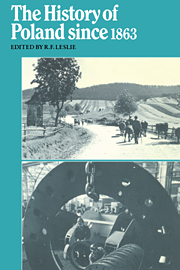Book contents
- Frontmatter
- Contents
- List of maps
- Preface to the paperback edition
- Abbreviations
- Map 1 Poland in the nineteenth century
- 1 Triloyalism and the national revival
- 2 Poland and the crisis of 1900–7
- 3 Poland on the eve of the First World War
- 4 The emergence of an independent Polish state
- 5 The breakdown of parliamentary government
- 6 Piłsudski in power, 1926–35
- 7 Poland without Piłsudski
- 8 Poland in defeat, September 1939–July 1941
- 9 The ill-fated alliance, August 1941–April 1943
- 10 The years of Tempest, May 1943–December 1944
- 11 Post-war Poland
- 12 The rise and ebb of stalinism
- 13 The October turning point
- 14 ‘The little stabilization’
- 15 The decline of Gomułka
- 16 Poland under Gierek
- 17 Polish society, 1945–75
- Epilogue: The rise and fall of Solidarity
- Notes
- Select bibliography
- Index
14 - ‘The little stabilization’
Published online by Cambridge University Press: 26 December 2009
- Frontmatter
- Contents
- List of maps
- Preface to the paperback edition
- Abbreviations
- Map 1 Poland in the nineteenth century
- 1 Triloyalism and the national revival
- 2 Poland and the crisis of 1900–7
- 3 Poland on the eve of the First World War
- 4 The emergence of an independent Polish state
- 5 The breakdown of parliamentary government
- 6 Piłsudski in power, 1926–35
- 7 Poland without Piłsudski
- 8 Poland in defeat, September 1939–July 1941
- 9 The ill-fated alliance, August 1941–April 1943
- 10 The years of Tempest, May 1943–December 1944
- 11 Post-war Poland
- 12 The rise and ebb of stalinism
- 13 The October turning point
- 14 ‘The little stabilization’
- 15 The decline of Gomułka
- 16 Poland under Gierek
- 17 Polish society, 1945–75
- Epilogue: The rise and fall of Solidarity
- Notes
- Select bibliography
- Index
Summary
The six years from the beginning of 195 7 to the end of 1963 were a period of comparative stability. The upheaval caused by the twin processes of destalinization and desatellization subsided rapidly after 1957, and the country settled down to life under Gomułka. Polish–Soviet relations and the internal situation fell considerably short of the hopes awakened by the October plenum, and many Poles felt that the PZPR was definitely in ‘retreat from October’, but for some years the retreat was slow. Many of the 1956–7 reforms remained in force, while the memories of the grim years of Stalinism and the Six Year Plan remained fresh in people's minds. Nor were Poles unaware how very different the situation continued to be in the rest of Eastern Europe. Gomułka's pragmatic approach to the task of‘ building socialism’ in Poland produced an uneasy equilibrium between Party aims and national aspirations. The two were to subside into a state of peaceful coexistence, marked by absence of serious conflict and tensions, and aptly nicknamed mala stabilizacja (the little stabilization). This stabilization proved short-lived. It was to be undermined by harsh economic policies to which Gomułka resorted when the political crisis was over. These in turn were caused by the inefficiency of the unreformed economic system, which was incapable of achieving high growth rates and rising living standards at the same time. Nevertheless the years 1957–63 represent the relatively successful half of Gomułka's rule in contrast with the far less happy seven years that followed. They earned him and Poland strong admiration in the West, expressed in numerous books sympathetic to him.
- Type
- Chapter
- Information
- The History of Poland Since 1863 , pp. 367 - 383Publisher: Cambridge University PressPrint publication year: 1980



